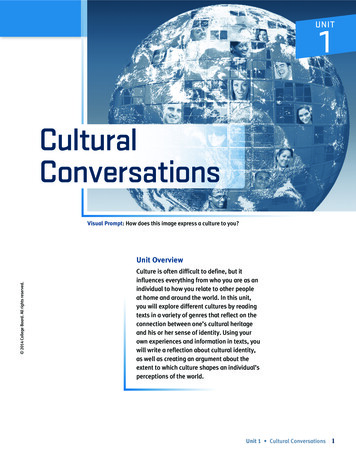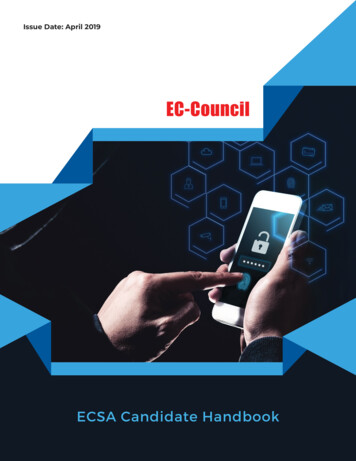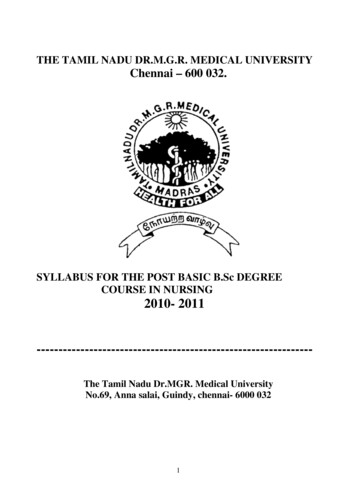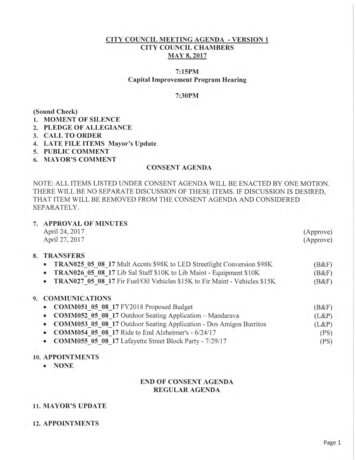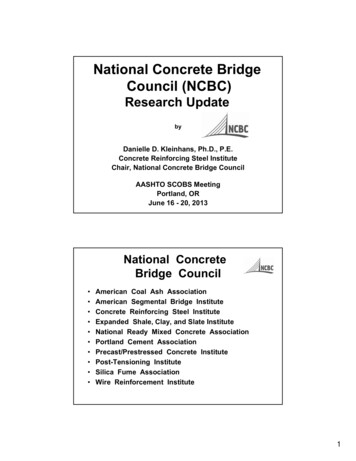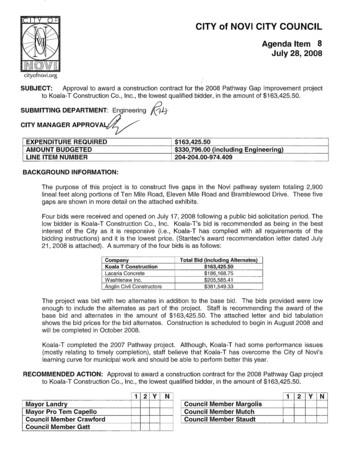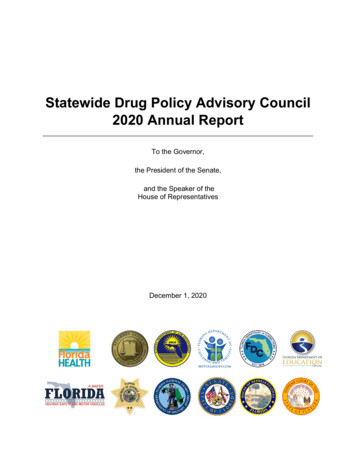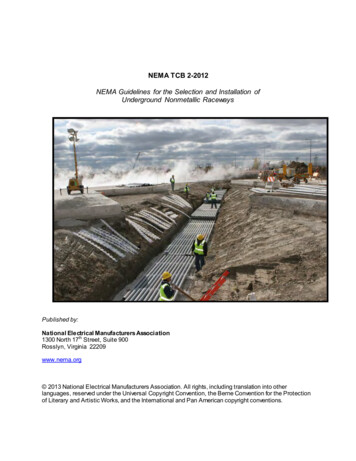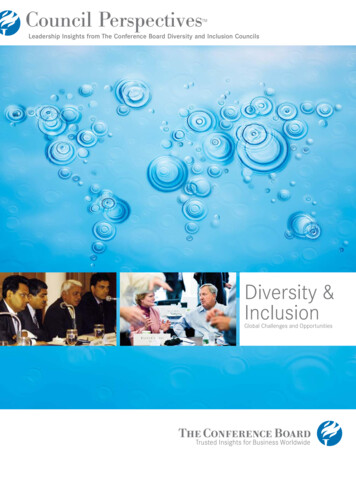
Transcription
Council PerspectivesTMLeadership Insights from The Conference Board Diversity and Inclusion CouncilsDiversity &InclusionGlobal Challenges and OpportunitiesTrusted Insights for Business Worldwide
Council PerspectivesTMThe Conference Board council members are among themost experienced and savvy executives in the world.Their private deliberations consist of rich insights on themost pressing business problems of our time. With theirpermission we have decided to channel their energy andexpertise and to give them a voice for their views. That“voice” is Council Perspectives . This new piece will bebased on sessions from selected council meetings, postmeeting interviews, and other pertinent data. CouncilPerspectives is not intended to be a research report butrather a unique look into the minds of executives in topglobal corporations as they weigh in on highly selectiveand important topics.
Diversity and InclusionGlobal Challenges and Opportunitiesby Charles Mitchell and Stephanie J. CrearyCP004ContentsCreating a Diverse and Inclusive Workplace around the WorldAchieving a Global MindsetRegional ChallengesBuilding an Effective D&I FunctionTaking a Business PerspectiveLinking to Other Functions across the OrganizationBuilding a Pipeline of Future D&I LeadersManaging through the Tough TimesMoving the Profession Forward: Metrics and Next StepsAbout This ReportList of Attendees
To better capture the dynamics of collaboration among councilmembers, The Conference Board employed a graphic facilitatorto illustrate in real time the topics and ideas that flowed from thediscussions. The graphics that accompany this report “map”participants’ conversations and reflect the patterns they saw andconnections they created between ideas.This “World Café” graphic, which is based on a series of breakoutsessions, underscores the importance of cultural competencyas an attribute for D&I professionals and highlights the subtlechallenges and issues they face on a region-by-region basiswhen they try to implement a global diversity program.Artist: Brandy Agerbeck of loosetooth.com (www.loosetooth.com)
C o u c i l Pe r s p e c t i v e s - Le a d e r s h i p I n s i g h t s f r o m T h e C o n fe r e n c e B o a r d D i v e r s i t y a n d I n c l u s i o n C o u n c i l sT h e C o n fe r e n c e B o a r d5Creating a Diverse and Inclusive Workplacearound the WorldFor diversity and inclusion (D&I) professionals, the challenges of building a diverse and inclusive workplace—both region by region and globally—can be daunting.Participants at the global joint meeting of The ConferenceBoard Diversity and Inclusion Councils spoke in broadterms about the need for a global mindset, and theyoffered specific suggestions for how to achieve it.Achieving a Global MindsetThere is no single globally accepted definition of “diversity.” Depending on the region of the world you operatein, it may connote issues of race, ethnicity, nationality,class, language, age, gender, sexual orientation, income,social class, physical ability, religion, or learning style. Itmay include all of these or none of them.For a diversity and inclusion strategy to be truly global,D&I professionals need to understand the culture, politics, economics, and relevant legislation within theregions in which their businesses operate, all of whichunderscores the critical importance of being culturallycompetent. More broadly, they should concentrate moreon the development of a global mindset and an international perspective and put less focus on exporting strategies that may work in one region but are irrelevant orineffective in another. Creating a global movementrequires diversity professionals to have experiences andinteractions with people outside of their home countryand their own comfort zone.Taking diversity and inclusion globally is not about theexport of specific programs, but about a creating a movement, and infusing energy into a global corporate valuesystem that includes diversity and inclusion as a fundamental concept. A critical issue that D&I professionalsstruggle with is how to keep the uniqueness of theirnational culture and still address the shared goal ofembedding diversity and inclusion into day-to-day operations.While each organization faces a unique set of challengesbecause of differing levels of D&I maturity, variances incorporate culture, and the number of countries involved,there are also crucial commonalities. Regardless of theirindustry or sector, all companies must address a lack ofequity around the world; there is also still a great deal ofmisunderstanding about how to define, leverage, andmeasure diversity and inclusion.Diversity and inclusion programs that are initiated andmanaged from the headquarters country, especially theUnited States, often face resistance. They are routinelydismissed by employees as having no relevance to theirbusiness, and a “Made in USA” label often raises a redflag for international employees.Given all of these factors, D&I professionals who seek tospread their message globally should keep the followingthoughts in mind.Listen and don’t dictate Avoid the common urge to tellpeople how to do it. Instead, ask them how they think itcan best be done.Think about the terminology Is it relevant for peopleoutside the headquarters country? For example, the term“minority” is considered U.S.-centric and may mean littleto employees outside of North America.Stop underestimating the complexity of being globalEven such basic tasks as gathering baseline data mayprove difficult or even impossible. There are differentlegal frameworks that do not allow affirmative action orthe ability to track age, race, nationality, etc.Establish a global mindset It really is about a globalway of thinking rather than a personal definition of diversity.Create a minimal framework that is driven by aglobal definition of diversity and inclusion but alsohighly localized One analogy: while all versions of thetelevision show Who Wants to Be a Millionaire? share thebasic framework of the original version from the UnitedKingdom, each has been made locally specific throughunique decisions about the value of the prizes, the natureof the questions asked, and the types of contestants thatare selected.Be aware that solutions imposed from outside won’talways be effective D&I executives should open a conversation that lets others come to the “aha” momentthemselves. To be engaged, locals need to feel that theyown the initiative.
6C o u c i l Pe r s p e c t i v e s - Le a d e r s h i p I n s i g h t s f r o m T h e C o n fe r e n c e B o a r d D i v e r s i t y a n d I n c l u s i o n C o u n c i l sLook for progress, not perfection How long did it takethe United States to progress? Other countries and cultures can’t be expected to get there in 24 hours.Challenge yourself Incorporate what you can learn fromthe rest of the world into your own home country program. We all have a lot to learn.w w w. c o n fe r e n c e - b o a r d . o r gefforts is a challenge, but if you don’t know what an EastAsian is thinking, you probably didn’t ask. The skill is inasking the right question and perceiving the unspokenrules (e.g., the decision maker is not the one who talksthe most; it is often the one who talks the least).CanadaRegional ChallengesThe different dynamics and definitions of diversity andinclusion around the globe have raised the profile of cultural competency and the importance of an executive’sability to do business effectively in any market, in anybusiness, and at any time. Political and economic contexts inform what goes on in the corporate sphere in anygeography. Presenters at the joint council meeting highlighted the subtleties that can have an impact on diversityand inclusion in a number of regions.AsiaEconomic differences It’s about the haves, the have nots,and the have a lots.Rapid technological change In terms of technology, theregion leapfrogged into the twenty-first century. Think ofthe Indian rice farmer with a cell phone.Regional differences Asia needs to be dissected on acountry-by-country basis. Even sub-regional clusters havevastly different cultures with different D&I issues.A mobile workforce Across all regions, the workforce isglobally aware and increasingly mobile. In fact, there is areverse brain drain from the West to the East.“Post-Americanism” The region is moving on withoutthe United States and is proud of it, which can have animpact on the implementation of a D&I program seen asoriginating in the United States. America is no longer thecountry that prescribes behavior.Corporate culture versus national culture Japanesewomen, for example, often join multinationals becausethey believe they will be more respected and appreciatedthan in a Japanese company bound by traditionalJapanese behavior and attitudes.Communication patterns Getting people who live andwork in the region to support diversity and inclusionThe Employment Equity Act The purpose of the Act,which was passed in 1986, is “to achieve equality in theworkplace” for women, visible minorities, people withdisabilities, and members of aboriginal communities.Unfortunately, the act doesn’t cover the country’s LGBTpopulation. Also, women aren’t advancing as fast and asfar as expected.Corporate social responsibility (CSR) CSR is anincreasingly important factor for employee engagement.The integration of D&I into business practicesDiversity and inclusion cannot be a stand-alone initiative.The current focus on the bottom line also means thatattention has been taken away from diversity and inclusion.Middle managers These leaders often do not see thevalue of diversity and inclusion.Additional challenges Problems associated with havingtwo official languages, the fact that a forecasted talentshortage is not occurring, and the difficulty of collectingdata on newly arrived immigrants and employmentequity.EuropeA shift away from the West As Western European markets become more mature, the immigration flow out ofEastern Europe is reversing, causing a labor shortage insome Western European countries.Birth rates Several Western European nations havedipped below replacement level for births.Gender This is an issue in the region, but not for allcountries. Internal regions are also very split on thisissue.Race Again, the importance of race as an issue variesfrom country to country, often depending on the historyof immigration in each nation. In some countries, thedebate is more about national origin or language issues,
w w w. c o n fe r e n c e - b o a r d . o r gC o u c i l Pe r s p e c t i v e s - Le a d e r s h i p I n s i g h t s f r o m T h e C o n fe r e n c e B o a r d D i v e r s i t y a n d I n c l u s i o n C o u n c i l swhile in others the treatment of locally born ethnicminorities is the hot topic.Resistance to D&I programs U.S. D&I programs aretypically revised for local conditions, but that is changingbecause of resistance and relevance. Europeans often dismiss U.S-centric. D&I programs based on gender andrace.Consumer diversity In Europe, diversity and inclusion ismore about internal talent and less about consumers, butthat is changing.Market differences Each geographic market in Europerepresents a unique entry point for diversity and inclusion. The different national laws and cultures make it aminefield.Latin AmericaPolitical context Democracy has grown across the regionvirtually uninterrupted during the last 25 years or so.Latin America also has two sitting presidents who arewomen—Michelle Bachelet of Chile and CristinaFernández de Kirchner of Argentina.Race This is still a difficult topic to talk about. As moreand more Latin American companies become multinationals, the focus tends to shift to gender and generationalissues.Religion While 80 percent of the population is Christian(predominantly Roman Catholic), Evangelical andPentecostal movements have taken hold in the last 15years, making this a growing diversity issue.Income diversity When it comes to inclusion, there isrampant discrimination and prejudice against low-incomepeople. Ensuring that low-income workers are treatedwith dignity and respect would be a revolutionary step.Even if the income gap is not addressed, greater respectwould be a step forward. Still, despite low incomes, theregion is a growth market, and 250 million low-incomeLatin Americans have purchasing power of 120 billion.Class This issue still trumps race in Latin America.7United StatesDemographics The United States is a first-world countrywith some hints of third-world demographics when itcomes to poverty and birth rates in certain populationsectors.Immigration One in seven workers is foreign born, and12.5 percent have master’s degrees, compared to 8 percent of the native population, according to the U.S.Census Bureau.Women According to Department of Labor statistics,women currently represent 46 percent of the total laborforce, and 40 percent are working in management, professional, and related occupations.Multiple generations in the workplace Baby boomersare staying on the job longer, which is creating a bottleneck and leaving Generation Xers and Millennials frustrated.Reverse discriminationDemographic shifts By mid century, the United Statespopulation will be more than 50 percent non-majority.Who is the consumer of the future? Who are we selling tooutside of our traditional customers?A “postracial society” With the election of PresidentBarrack Obama, some are saying the United States hasentered a “postracial” era, and diversity and inclusiondoesn’t need to exist as a function.Lesbian, gay, bisexual, and transgender issues Theseconcerns are increasingly receiving more attention.
8C o u c i l Pe r s p e c t i v e s - Le a d e r s h i p I n s i g h t s f r o m T h e C o n fe r e n c e B o a r d D i v e r s i t y a n d I n c l u s i o n C o u n c i l sGoing Global at DiageoDiageo is a global leader in the premium drinks market andtrades in more than 180 markets, employing more than22,000 people around the world. Headquartered in theUnited Kingdom, its shareholding is about evenly splitbetween the United Kingdom and the United States. At the2009 Corporate Diversity and Inclusion Conference, CherieSheridan, director for learning and development at Diageo,North America, Inc. provided insight into the challenges andstrategies needed to launch a successful diversity and inclusion program on a global scale.Diageo’s diversity and inclusion initiative was founded on theprinciple “that every employee has potential and that by creating the conditions for them to grow will improve Diageo’sbusiness performance.” Launched in North America in 2007,this program was expanded globally to all people managersin 2008, beginning with a pilot program in London thatincluded participants from Africa, Brazil, UK, Spain, andSweden.The drivers and goals for the Diversity & Inclusion programhave always been aligned with Diageo’s broader performance objectives and contribute to business growth. The drivers and goals included: Ensure that you understand any legal obligations andcompliance issues that may affect the material being presented Be aware of significant events taking place in the country Provide opportunities for leadership to prepare theirlift/elevator speeches Educate the team Establish global definition of diversity and inclusionWhen defining multiculturalism or diversity, provideopportunities for participants to define what they see asthe primary challenges within their corporate culture. You must have examples of success factors that can bedirectly tied to diversity of perspective, people,approaches, etc., which can be presented to the group tobuild the rationale for the business case. When questions, conflicts, and concerns arise that are instark contrast to cultural norms, it is important to link alllearnings to the core values of the company.“Simply the right thing to do”Developing the programForm a global planning team: Conduct interviews with primary stakeholders in advanceto create relevant case studies and opportunities for discussionsCommunicate Consumer insightsDesignCreate a Global Facilitators NetworkSimulations: adjust simulations to reflect cultural normsthat will likely be present in the audience.Create an authentic work environmentDiageo learned valuable lessons through the design, contentdevelopment, and delivery process of the initiative that arerelevant for any company wishing to embark on a globaldiversity and inclusion journey. Among them:Choose an external consultant for subject matter expertiseContentWar for talentIncrease our support to minority suppliersPay attention to the fact that the organization’s culturemay be stronger than some aspects of the country’s culture Changing demographicsIncrease employee engagementw w w. c o n fe r e n c e - b o a r d . o r gDeliveryPilot Programs: outside of the United States Language impact: Be mindful of the fact that when people are learning in a language that is not their nativetongue, it requires a far greater degree of concentrationand energy to successfully navigate the materials. Provide opportunities for action planning. Use multicultural teams to deliver messages.Materials: Reduce the amount of material you have inyour headquarters version, because everything will takemuch longer due to language, translation, etc.
In addition to the role of the D&I professional, the diversity and inclusion function is changing due to rapid technological advancements,globalization, immigration, increased demand for skills and education,and an aging workforce in a large part of the world. The emphasistoday is on cornering new markets, building effective and efficientglobal teams, and managing brand reputation. Clearly, the twenty-firstcentury D&I practitioner who will embrace this more public, decidedlystrategic role will require a challenging new set of competencies.This graphic captures attendees’ ideas about the evolving role of thediversity practitioner, the new competencies required, and both thestrategy and the tactics needed to implement a global D&I program.Artist: Brandy Agerbeck of loosetooth.com (www.loosetooth.com)
10C o u c i l Pe r s p e c t i v e s - Le a d e r s h i p I n s i g h t s f r o m T h e C o n fe r e n c e B o a r d D i v e r s i t y a n d I n c l u s i o n C o u n c i l sT h e C o n fe r e n c e B o a r dBuilding an Effective D&I FunctionAlthough participants spent significant time examiningthe external challenges to the creation of a diverse andinclusive workforce, their discussions also addressed theinternal challenges diversity and inclusion professionalsface. Through these conversations, participants were ableto identify four areas that are critical to ensuring that theD&I function has impact and adds value:1 Ensure D&I takes a business perspective2 Link D&I to other functions across the organization3 Build a pipeline of future D&I leaders4 Sustain momentum during tough economic times1 Taking a Business PerspectiveThe days when D&I programs could get by as “add-ons”or as simply “the right thing to do” are gone. Executiveswant to know that D&I professionals understand the business and can customize a diversity strategy that helps theorganization and specific departments accomplish theirstrategic goals. Leaders also want to have confidence thatD&I executives can deliver a plan that works for thewhole company.Wanted: a new model of D&I leadershipPersistence and passion are the recognized hallmarks ofdiversity executives, but a different business environmentand the demands of being a global business partnerrequire more than these two admirable qualities. Today,change management is at the heart of the D&I function,and it is mandatory for the alignment of D&I prioritieswith business objectives. With corporations developingnew directions and strategies every three to five years,the ability to redirect change—something D&I executivesdo all the time—can support evolving business objectives. Diversity executives should recognize this qualityand flaunt it within the organization.D&I executives also need to move away from measuringtheir worth by “activity.” The mindset needs to be aboutstrategy and impact. You need to look at diversity andinclusion in a vastly different way. It is a whole new ballgame, and if you don’t change your game, you will simply not be invited to play. Stop focusing on “how busyyou can be” and “making lists”, and instead place thefocus on D&I’s impact on the business, both in the shortand long terms. The case for diversity has to start withthe needs of the company, an understanding of how thecustomer is changing, and the ability of D&I executivesto meet those needs down to the business unit level.D&I is a business functionOne fact the current global recession has taught executives is that there is nothing like an economic downturnto sharpen company focus and priorities. Many organizations are waging battles on multiple fronts. In addition toan external conflict with competitors for markets, capital,and, in extreme cases, survival, there is an internal struggle between functions for attention, resources, andrecognition.Another certainty that is emerging from the economicrubble of the current recession, which is the worst in twogenerations, is that the role of and the conversation aboutdiversity and inclusion has changed for good. And,according to many professionals in the field, it’s abouttime. The diversity and inclusion role is now, more thanever, a business one and the function needs to operateaccordingly if it wants respect, resources, and the attention of potential partners and collaborators. To be integrated into business functions, D&I executives must notonly align themselves and their function with corporatestrategy, they must also strive to influence that strategy.A new role for D&I executives:business strategistAs part of the shift in the definition of the diversity andinclusion function, D&I executives must become solutions providers. They need to be able to help their companies think more broadly when they enter new markets,build high-functioning global teams, and look for ways toenhance corporate brands and reputations. If the functioncan prove its ability to meet important challenges, seniormanagement and business units will begin to consider theD&I department a strategic partner. This is already happening in those companies where the value of D&I hasbeen clearly formulated and publicly stated.
w w w. c o n fe r e n c e - b o a r d . o r gC o u c i l Pe r s p e c t i v e s - Le a d e r s h i p I n s i g h t s f r o m T h e C o n fe r e n c e B o a r d D i v e r s i t y a n d I n c l u s i o n C o u n c i l sIn the role of business strategist and consultant, D&Iexecutives must clarify the definition of diversity andinclusion within their organizations. More important, theymust learn about the business from the perspective of themangers they hope to convert. The basic lesson here isthat you must know the business before you expect business mangers to understand the value of diversity. Anenhanced understanding of the entire organization willhelp D&I professionals clearly and specifically communicate their plans and define what winning means for thebusiness in practical terms. Useful questions to ask during this learning phase include:about performance and relevance that run the risk ofoffending the powers that be or creating the impressionthat the D&I function is not a team player. Diversity andinclusion executives must also reach across functions toengage individuals who may have previously foundexcuses not to talk about diversity and inclusion.Courageous communication means finally tackling thoseissues that are frequently talked about but never actedupon.If D&I executives are to challenge the perspectives ofothers, they must be willing to subject themselves to thesame rigorous analysis. D&I leaders should consider thetimes when they were able to speak out and the timesthey did not. As a D&I champion, you simply cannotstand by when you see things that are not inclusive or seepeople making decisions that are counter to the values ofyour corporation. Don’t assume that your reality is someone else’s reality. Be courageous and speak up. Challengeothers’ perspectives. Are we valued in our business organization for whatwe contribute to the bottom line? Do we have a solid value proposition and business casethat can be measured in terms C-suite functionsunderstand? Are we delivering on it?By gaining a genuine understanding of how businessunits operate, D&I executives can change the perceptionthat diversity and inclusion is an imposition and reinforcehow it has to become a part of the corporate culture. Thisis especially needed at the business unit level, whereresistance to D&I initiatives can be higher.1 Major projects should include the integration of diversity and inclusion into the company’s operations so that it influencesall aspects of the organization and the creation of a common organizational language around diversity and inclusion. If the company’s D&I ethic becomes part ofday-to-day operations, it never leaves.The importance of courageouscommunicationCourageous conversations, crucial conversations, courageous communication, critical interventions—regardlessof the term, D&I executives must tackle the tough issues,ask the hard questions, and force organizations to confront weaknesses or address subjects they would otherwise choose to avoid or ignore. Their task is to movebeyond the paralyzing cordiality that sometimes infectscompanies, especially in good times, to address issues1 For a discussion of the D&I role of middle management, seeMiddle Managers: Engaging and Enrolling the Biggest Roadblock toDiversity and Inclusion, The Conference Board, Executive Action234, April 2007, which is based on discussion at a November2006 meeting of the Diversity Business Council.11Tips for Expanding the Roleof Diversity and InclusionD&I executives should: Be flexible, aware, and resilient Be practical and make business sense Persuade partners that their business needs are drivingthe agenda Maximize the function’s role as a strategic talentmanagerBe good listenersActively manage risk, acknowledge the economicdownturn, and work to get people on their sideUnderstand and appreciate the current crisis“Select and direct” and focus on the human elementAlways relate D&I to the business and emphasize tiesto business outcomes
12C o u c i l Pe r s p e c t i v e s - Le a d e r s h i p I n s i g h t s f r o m T h e C o n fe r e n c e B o a r d D i v e r s i t y a n d I n c l u s i o n C o u n c i l sDon’t fight the system—work with itIn the past, diversity and inclusion was often viewed asa problem that needed to be fixed. Today, such a mindsetwill only make D&I that much harder to embed withinthe organization. With companies and CEOs demandingmore engagement, more innovation, and more productivity, diversity and inclusion needs to be seen as part of thesolution. And as D&I executives know, and other business managers are beginning to learn, you get betterbusiness decisions when you have diverse perspectivesin the room.D&I executives need to redefine diversity in a muchbroader context. Business leaders are all about innovationand growth, and D&I executives need to talk that talk. Ifyou use the old language of diversity based on an outdated model of an emotive experience and qualitativemeasures, you are probably not aligned with the rest ofthe organization. If it is not tied to the business agenda,diversity and inclusion becomes “a nice thing to do.” If itdoes not translate into growth in the business it becomesa secondary priority. Alter the perception from cost centerto profit center, tie diversity and inclusion to cost savings(higher retention rates), productivity gains (a moreengaged workforce), and revenue growth (new markets).2 Linking to Other Functions acrossthe OrganizationAs part of its effort to demonstrate the real value ofdiversity and inclusion to an organization, the D&I function must partner or work directly with other departmentsand programs. D&I professionals at both the global diversity councils meeting and the Diversity and InclusionConference cited four key areas where a robust and business-focused D&I program can show its contribution tooverall corporate success.2 Source: 2008 National Population Projections, U.S. CensusBureau jections.html).3 Sources: Euro-Mediterranean Statistics, Eurostat, 2009, p. 24(Italy, Spain, and Germany); Statistical Handbook of Japan 2009,Statistical Bureau, Ministry of Internal Affairs andCommunications, p. 15 (Japan).w w w. c o n fe r e n c e - b o a r d . o r gMarketing: Offer insights into theneeds of the new consumerWhat is an essential role in today’s corporation and economic environment? The answer often depends on thecustomer. Essential roles are those that connect to thecustomer, build relationships with them, and, in the end,add shareholder value. If diversity and inclusion is notoperationalized to be part of essential roles in the business, then it will be on the outside looking in. If it’s notin the annual operating plan, it is often considerednonessential.Recent demographic and labor shifts give D&I a newopportunity to help organizations who are expandingtheir operations around the world. These developmentsare enablers of global growth. For example, according tonational population projections released by the U.S.Census Bureau in August 2008, the U.S. minority population is expected to account for more than half of the totalU.S. population by 2050, and their economic buyingpower will only continue to grow.2 Birth rates in Italy,Spain, Germany, and Japan are all below replacementlevel, signaling a worsening labor shortage in the future.3India is projected to have 47 million surplus workers by2020.4 D&I executives of global companies offer uniqueinsights that can help thei
on the development of a global mindset and an interna-tional perspective and put less focus on exporting strate-gies that may work in one region but are irrelevant or ineffective in another. Creating a global movement requires diversity professionals to have experiences and interactions with people outside of their home country

